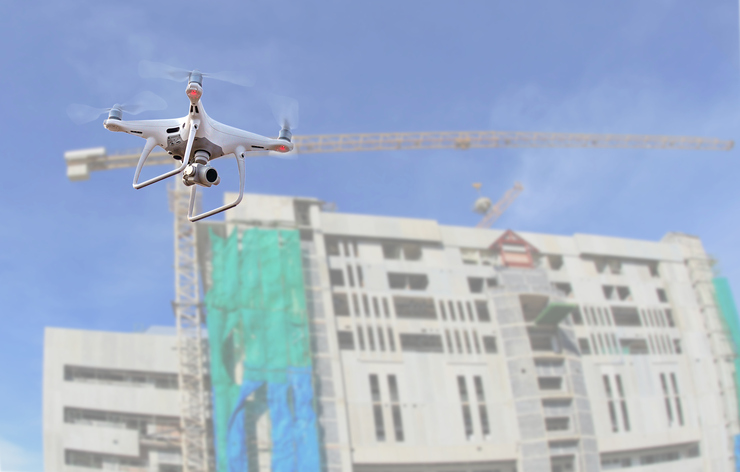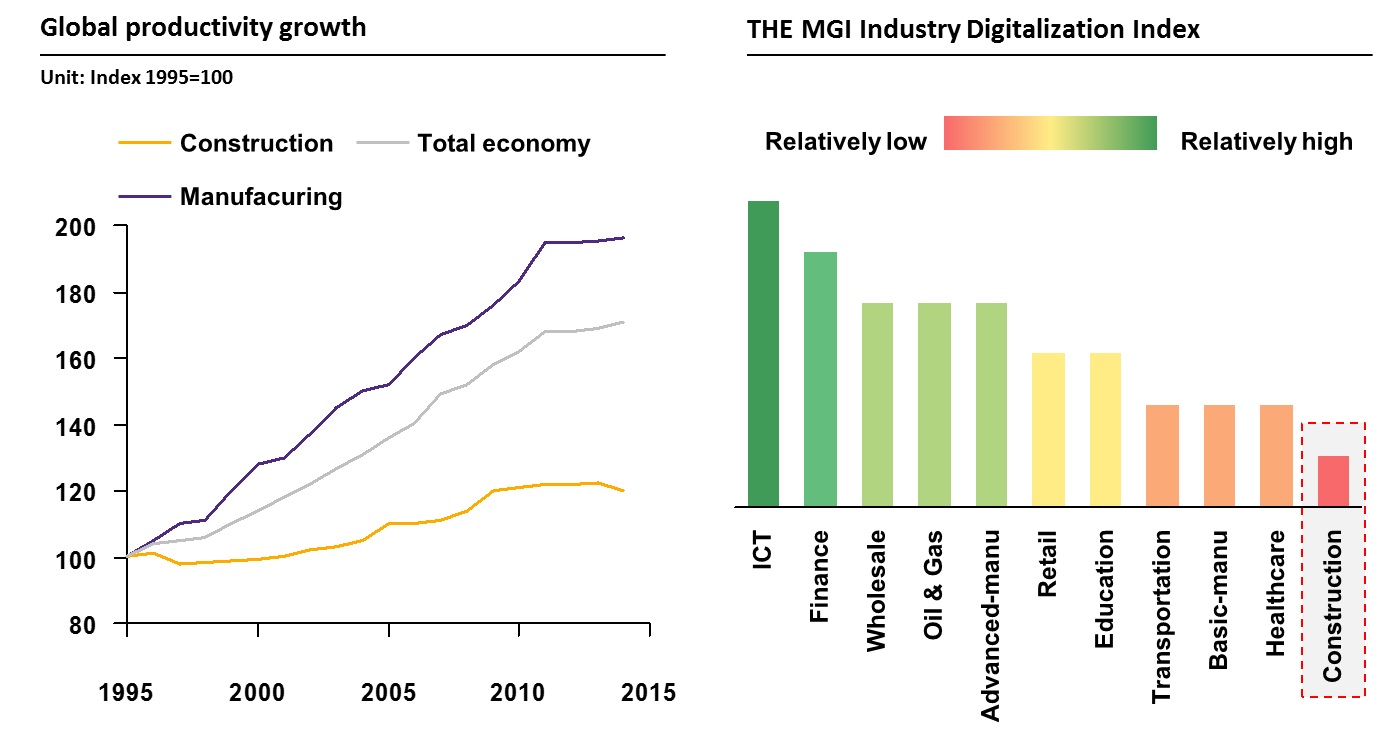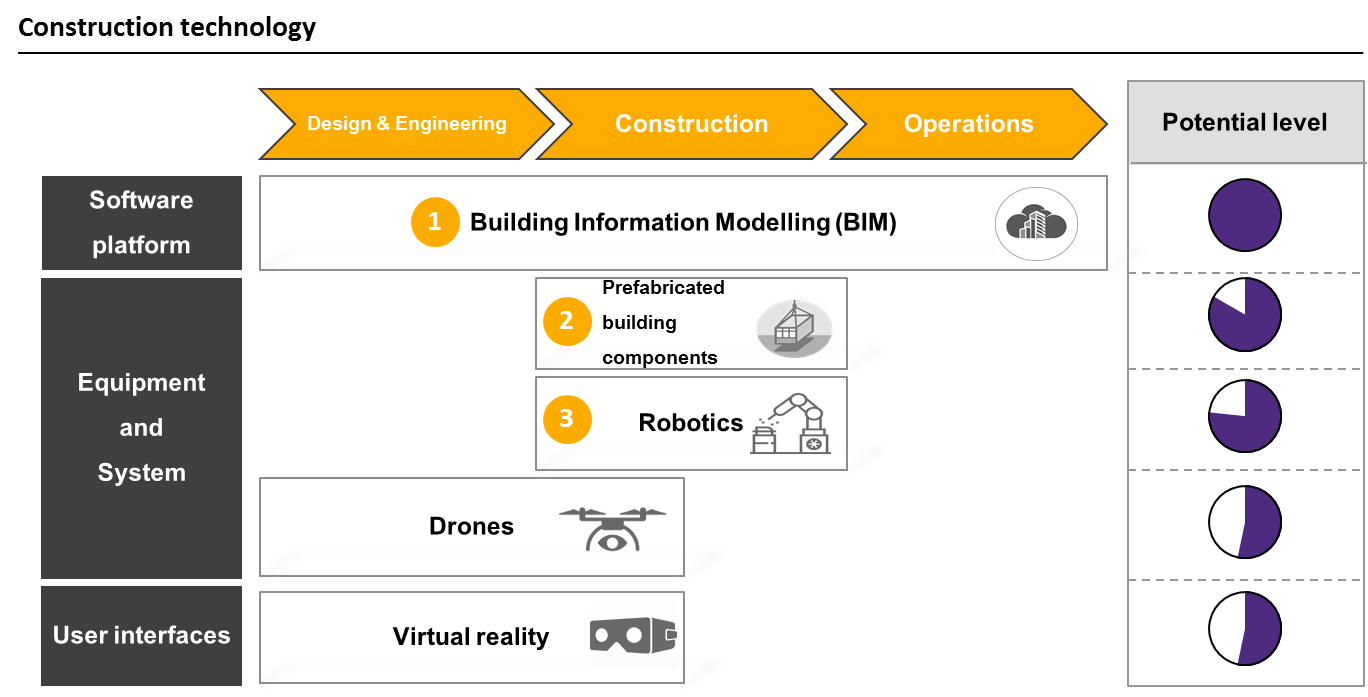Construction Technology: Advanced methods to empower contractors
Productivity issues, labour shortages, and high costs related to wages are fundamental challenges that the construction sector in both Thailand and abroad always have to face. In the current climate, these challenges are likely to increase as reflected in the poor performance of the construction sector in relation to other industries. Furthermore, EIC analysis shows that contractors in Thailand will face a significant labour shortage by about 50,000 workers in 2018 while this figure is likely to rise over the next 3 years.
Author: Kanchanok Bunsupaporn 
|
Highlight
|
The global construction sector is still circling around productivity issues and labour shortages that are growing in severity. Productivity growth of the construction sector is still lower than other industries. The adaptation of technologies to help construction works is also low when comparing to other sectors (Figure 1). Furthermore, the majority of contractors are facing problems related to business performance that is reflected in a research by Autodesk who found that 60% of contractors in various countries are having issues of escalating costs and construction delays. These issues are partly related to the changes made during constructions.
In terms of labour, EIC analysis suggests that between 2018-2020 Thai contractors could face the issue of labour shortages by around 50,000 to 200,000 workers per year. This is due to the growing needs for labour from government contracts. At the same time, it is expected that the number of migrant workers will reduce following the coming into effect of the Royal Ordinance Concerning the Management of Foreign Workers’ Employment 2018. In addition, contractors will have to face the issue of rising labour costs from the increase of minimum wage rates such as in 2018 when minimum wage rates in Bangkok area rose by 5% to THB 325 per day (Figure 2)
Construction technology is the new hope in solving the issues faced by the construction sector in which the technologies can be divided into 3 groups. These are 1) Software platform such as Building Information Modeling (BIM) 2) Equipment and system including prefabricated building components (Prefabs), as well as construction robotics and 3) User interface such as Virtual Reality (VR) Additionally, construction technologies can be adapted to suit various value chain activities of the construction business (Architecture, Engineering and Construction Industry or AEC Industry) that cover architecture, engineering, construction, as well as building management depending on applicable technological functions.
EIC expects BIM, Prefabs, and construction robotics to become the 3 technologies that transform the construction industry. This expectation is based on the factors of possibility in adapting technologies to be used, coverage of functions related to the value chain, and the performance level in addressing productivity and labour issues (Figure 3). The aforementioned technologies can significantly improve construction performance.
1) BIM: A low-cost, high-value technology but still have issues relating to labour skills and the need to adjust the whole value chain system that raise doubts among contractors BIM is a 3D modelling technology of building that allows effective calculation of the BOQ (Bill of Quantities) unlike traditional CAD (Computer Aided Design) while also facilitating every stage of the process from designing to the actual construction. Consequently, BIM helps reducing repetitiveness and conflict in the process. The functions that cover the value chain also have positive consequences for related businesses including property development, design agency, construction business, and interior designer. A research conducted by Autodesk found that adaptation and utilisation of BIM help to reduce the length of time needed for designing by as much as 30% and reduce labour requirement in a construction site by about 25%.
Nevertheless, should contractors want to invest in this technology, they will have to invest in two particular aspects which are the purchase of the BIM software and labour training. The associated costs are THB 250,000 for the software and THB 30,000 for a training course. EIC expects that BIM will help saving costs by as much as 1 – 8.5 times for a project valuing at THB 100 – 1,000 million. Despite the considerable advantage of using the BIM, the adoption of BIM in Thailand is still limited to larger enterprises because full-utilisation of BIM requires labour training and the changeover in document storage practice from paper-based to digital which is not easy in reality. Furthermore, adoption of BIM also requires every stakeholder in the value chain to also adopt BIM.
2) Prefabs help to reduce costs and time require constructions and if contractors invest in producing own Prefabs they could save as much as 3 times the costs. Prefabs are ready-made building materials, such as pre-made walls and pillars, that are made in a factory or in the construction area prior to installation in a building. Research in USA, New Zealand, and Hong Kong, and also Thailand among Prefabs users found that Prefabs help save labour costs by 5-20% depending on construction materials and building type. Prefabs also help reduce construction time by about 20% amounting to a reduction in overall construction costs by more than 10%.
Contractors can obtain Prefabs from two major sources: either by purchasing from other contractors or invest in a factory that builds Prefabs. Both options come with different advantages and disadvantages. In terms of purchasing, contractors face risks of price fluctuations and delivery issues. Meanwhile, investing in own factory require high capital outlay. As an example, a Prefabs factory in Thailand that is capable of producing 300,000 square metres per year require an investment of over THB 1,000 million. However, EIC also expects that if a contractor decides to invest in building a Prefabs factory, they could receive ROI as high as 16%, 6% higher than purchasing Prefabs from others due to differences in capital costs whereby costs of making own Prefabs is around 700-780 baht per square metre while purchasing will cost as much as 800-900 baht per square metre. Nevertheless, to make it worthwhile in making own Prefabs, contractors must be able to produce at least 60% of total production capacity.
3) Construction robotics are useful in addressing labour issues and the adoption rate in Thailand is expected to increase over the next 10 years. Construction robotics are gaining increasing popularities in USA, Australia, and the UK. In particular, welding and bricklaying robots are worth keeping an eye on, as they can help to speed up constructions by over 10 times and 5 times respectively. Subsequently, labour costs can be reduced by as much as 50% and 30%.
Based on EIC analysis, it is not yet worthwhile for Thai contractors to invest in construction robotics. This is because the costs of investing in robots are currently higher than employing labour in Thailand. It will be worthwhile to adopt construction robotics when wages are at the level of THB 700 and THB 600 per person per day for welding and bricklaying robots respectively. In the future, the increase in robotic performance and reducing costs will make an investment in construction robotics worthwhile when the costs are lower than labour.
In addition to the mentioned construction technologies, there are also other useful technologies that can be applied in all industrial businesses, as well as constructions. These are 3D printing, Internet of Things (IoT), and big data analytics which will play in increasing role in the near future. Businesses need to carefully consider positive and negative aspects of each technology to make the most use of them.
|
|
|
|
|
Figure 1: Construction sector faces a problem of lower productivity in comparison to other industries. Furthermore, there is also a lack of adaptation of technologies to assist the business.

Note: Construction productivity growth rate is calculated using data from 41 countries with a combined GDP of 96% of the world’s total GDP.
Source: EIC analysis based on data from WEF and McKinsey
Figure 2: Labour issue comprises two main problems: labour shortages and higher labour costs.

Source: EIC analysis based on data from BOT, DOE, and MOL
Figure 3: 3 high-performance technologies that are worth keeping an eye on: Building Information Modeling (BIM), prefabricated building components, and construction robotics.

Note: Potential level is considered from 3 factors including likelihood, value chain coverage, and labour & efficiency solution
Source: EIC analysis based on data from BCG and WEF